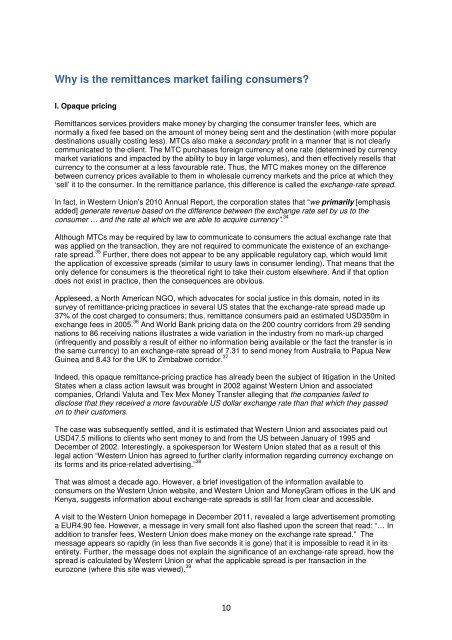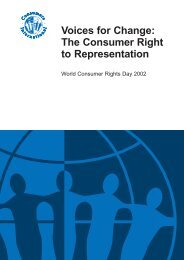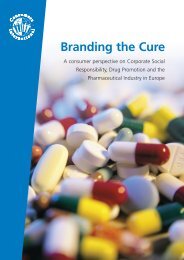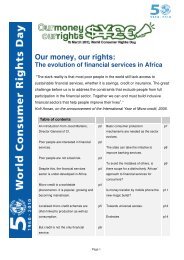The remittances game of chance: playing with loaded dice? January ...
The remittances game of chance: playing with loaded dice? January ...
The remittances game of chance: playing with loaded dice? January ...
Create successful ePaper yourself
Turn your PDF publications into a flip-book with our unique Google optimized e-Paper software.
Why is the <strong>remittances</strong> market failing consumers?<br />
I. Opaque pricing<br />
Remittances services providers make money by charging the consumer transfer fees, which are<br />
normally a fixed fee based on the amount <strong>of</strong> money being sent and the destination (<strong>with</strong> more popular<br />
destinations usually costing less). MTCs also make a secondary pr<strong>of</strong>it in a manner that is not clearly<br />
communicated to the client. <strong>The</strong> MTC purchases foreign currency at one rate (determined by currency<br />
market variations and impacted by the ability to buy in large volumes), and then effectively resells that<br />
currency to the consumer at a less favourable rate. Thus, the MTC makes money on the difference<br />
between currency prices available to them in wholesale currency markets and the price at which they<br />
‘sell’ it to the consumer. In the remittance parlance, this difference is called the exchange-rate spread.<br />
In fact, in Western Union’s 2010 Annual Report, the corporation states that “we primarily [emphasis<br />
added] generate revenue based on the difference between the exchange rate set by us to the<br />
consumer … and the rate at which we are able to acquire currency”. 34<br />
Although MTCs may be required by law to communicate to consumers the actual exchange rate that<br />
was applied on the transaction, they are not required to communicate the existence <strong>of</strong> an exchangerate<br />
spread. 35 Further, there does not appear to be any applicable regulatory cap, which would limit<br />
the application <strong>of</strong> excessive spreads (similar to usury laws in consumer lending). That means that the<br />
only defence for consumers is the theoretical right to take their custom elsewhere. And if that option<br />
does not exist in practice, then the consequences are obvious.<br />
Appleseed, a North American NGO, which advocates for social justice in this domain, noted in its<br />
survey <strong>of</strong> remittance-pricing practices in several US states that the exchange-rate spread made up<br />
37% <strong>of</strong> the cost charged to consumers; thus, remittance consumers paid an estimated USD350m in<br />
exchange fees in 2005. 36 And World Bank pricing data on the 200 country corridors from 29 sending<br />
nations to 86 receiving nations illustrates a wide variation in the industry from no mark-up charged<br />
(infrequently and possibly a result <strong>of</strong> either no information being available or the fact the transfer is in<br />
the same currency) to an exchange-rate spread <strong>of</strong> 7.31 to send money from Australia to Papua New<br />
Guinea and 8.43 for the UK to Zimbabwe corridor. 37<br />
Indeed, this opaque remittance-pricing practice has already been the subject <strong>of</strong> litigation in the United<br />
States when a class action lawsuit was brought in 2002 against Western Union and associated<br />
companies, Orlandi Valuta and Tex Mex Money Transfer alleging that the companies failed to<br />
disclose that they received a more favourable US dollar exchange rate than that which they passed<br />
on to their customers.<br />
<strong>The</strong> case was subsequently settled, and it is estimated that Western Union and associates paid out<br />
USD47.5 millions to clients who sent money to and from the US between <strong>January</strong> <strong>of</strong> 1995 and<br />
December <strong>of</strong> 2002. Interestingly, a spokesperson for Western Union stated that as a result <strong>of</strong> this<br />
legal action “Western Union has agreed to further clarify information regarding currency exchange on<br />
its forms and its price-related advertising.” 38<br />
That was almost a decade ago. However, a brief investigation <strong>of</strong> the information available to<br />
consumers on the Western Union website, and Western Union and MoneyGram <strong>of</strong>fices in the UK and<br />
Kenya, suggests information about exchange-rate spreads is still far from clear and accessible.<br />
A visit to the Western Union homepage in December 2011, revealed a large advertisement promoting<br />
a EUR4.90 fee. However, a message in very small font also flashed upon the screen that read: “… In<br />
addition to transfer fees, Western Union does make money on the exchange rate spread.” <strong>The</strong><br />
message appears so rapidly (in less than five seconds it is gone) that it is impossible to read it in its<br />
entirety. Further, the message does not explain the significance <strong>of</strong> an exchange-rate spread, how the<br />
spread is calculated by Western Union or what the applicable spread is per transaction in the<br />
eurozone (where this site was viewed). 39<br />
10







![pkef]Qmf eg]sf] s] xf] < - Consumers International](https://img.yumpu.com/6479658/1/184x260/pkefqmf-egsf-s-xf-consumers-international.jpg?quality=85)